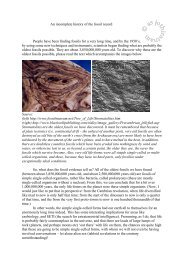Cenozoic birds and reptiles The Cenozoic (also Cainozoic or ...
Cenozoic birds and reptiles The Cenozoic (also Cainozoic or ...
Cenozoic birds and reptiles The Cenozoic (also Cainozoic or ...
You also want an ePaper? Increase the reach of your titles
YUMPU automatically turns print PDFs into web optimized ePapers that Google loves.
Source: http://en.wikipedia.<strong>or</strong>g/wiki/Aepy<strong>or</strong>nis <strong>The</strong> elephant bird of Madagascar, which<br />
stood over 3 metres tall (so a 2 metre human st<strong>and</strong>ing next to this bird would just come up to<br />
the base of its neck), displayed together with its egg, which had a circumference of just over<br />
a metre! This animal was one of the many species to have gone extinct as a result of contact<br />
with humans. Whatever the opposite of the Midas touch is (the Sadim touch?), we certainly<br />
seem to have it as far as biodiversity <strong>and</strong> ecology are concerned.<br />
As I mentioned earlier, during much of the time that terr<strong>or</strong> <strong>birds</strong> walked the Earth,<br />
South America was an isl<strong>and</strong> continent, <strong>and</strong> its unique cargo of species evolved in isolation<br />
from the rest of the w<strong>or</strong>ld. <strong>The</strong>n, three million years ago, the two American continents were<br />
connected. This allowed N<strong>or</strong>th American predat<strong>or</strong>s, such as jaguars <strong>and</strong> sabre-toothed cats, to<br />
invade South America, where they outcompeted the remaining terr<strong>or</strong>-bird species, driving<br />
them to extinction.<br />
Relatively little is known about the life-styles of the terr<strong>or</strong> <strong>birds</strong>. Since there are no<br />
large, flightless carniv<strong>or</strong>ous <strong>birds</strong> alive today, scientists cannot observe <strong>and</strong> extrapolate from<br />
them, <strong>and</strong> must instead turn to observations of the smaller flightless carniv<strong>or</strong>ous <strong>birds</strong>, like the<br />
secretary bird of Africa, <strong>and</strong> the seriema of S. America to garner clues as to how the large<br />
<strong>birds</strong> might have behaved. One big problem with this approach is that neither the secretary<br />
bird, n<strong>or</strong> the seriema is the top predat<strong>or</strong> in its ecosystem, but the terr<strong>or</strong> <strong>birds</strong> probably were, so<br />
behavioural extrapolations are likely to be tenuous. In addition, few complete terr<strong>or</strong>-bird<br />
fossils have been unearthed, thus complicating matters even further.<br />
Researchers still do not know if terr<strong>or</strong> <strong>birds</strong> hunted in groups – as velocirapt<strong>or</strong>s<br />
(bipedal dinosaurs who share a similar body shape) are thought to have – <strong>or</strong> alone, as jaguars<br />
<strong>or</strong> tigers do today. That they were meat-eaters is fairly certain, based on the f<strong>or</strong>m <strong>and</strong><br />
structure of their beaks, which resemble those of predat<strong>or</strong>y eagles <strong>and</strong> scavenging vultures.



